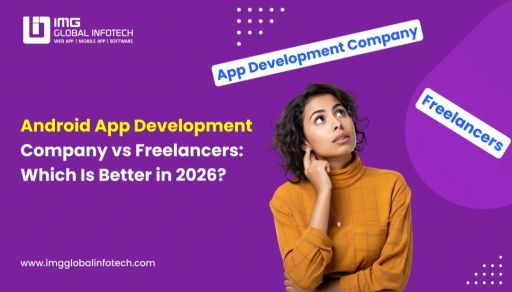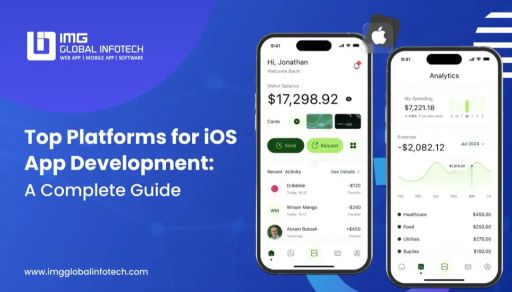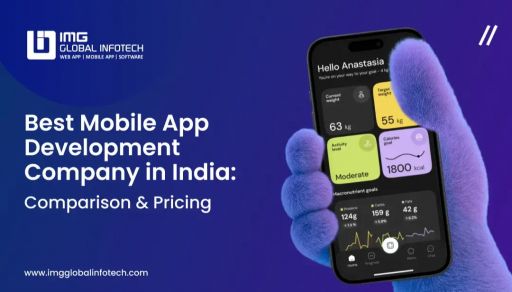How Much Does It Cost To Build A Mobile App In 2026? [Updated]
Dipti Singhal
Nov 13, 2025
![How Much Does It Cost To Build A Mobile App In 2026? [Updated] How Much Does It Cost To Build A Mobile App In 2026? [Updated]](https://d1y41eupgbwbb2.cloudfront.net/images/blog/blogimageHow-Much-Does-it-Cost-to-Build-an-App-in-2024-A-Comprehensive-guide.webp)
When planning to build a mobile app, the very first question that comes to mind is — “How much does it cost to develop an app in 2026?”
It’s a fair question and one that doesn’t have a simple, one-size-fits-all answer. Whether you’re a startup founder with a fresh app idea or an established business looking to digitize operations, understanding the mobile app development cost in 2026 is the first step toward making informed decisions.
From concept to launch, costs to building an app from scratch really can vary greatly based on features, complexity, and platform.
Estimated Mobile App Development Costs in 2026: A Quick Breakdown
In 2026, the cost to build an app typically ranges from $10,000 to $150,000 or more, depending on various critical factors. A basic app with limited functionality might cost around $8,000 to $25,000, while a mid-level app with custom features, APIs, and moderate complexity could fall in the range of $25,000 to $60,000. For advanced, enterprise-grade, or feature-rich apps - think food delivery, dating apps, or marketplace platforms, the development cost may exceed $150,000+ especially when AI, real-time syncing, or third-party integrations are involved.
In this guide, we outline the all-critical factors that determine the cost of app development:
Factors That Affect the Cost to Develop Mobile App
Here are the factors that determine the Cost of Developing an App in a friendly and engaging explanation:
-
Complexity of the App
Your level of application complexity is a great player in the Mobile App Development Cost. Advanced features or intricate designs require you to pay a bit more. In terms of that, the basic features of any app can lower development costs.
So, identify the functionalities you need. Keeping it simple will help reduce the cost of mobile application development and get you what you want.
-
Platform Choice
You also have a decision to make between iOS and Android app development.
Depending on which you're opting for, there are guidelines and a set of development tools, which can influence your budget.
If you're aiming for cross-platform development, remember that you might save some cost of developing a mobile application, but you have to compromise a little bit on performance.
It is therefore important to weigh your options carefully.
-
Design Quality
If you look at the best mobile apps in India or in the USA, you will find they all have eye-captivating designs and top features.
Do not think that design does not cost much.
Quality, user-friendly, and highly effective designs can boost the success of your app. However, they also increase the cost to make mobile applications. Whereas, a simple and minimalistic design can be cost-effective.
A great design investment may mean better user engagement.
-
Development Team Location
Where your development team is based has a major impact on the cost.
You can hire mobile app developers from regions that charge less, thus saving you quite a few dollars. Such as mobile app development cost in India is lesser as compared to the USA or UK.
But make sure they are in good records.
Quality is always an issue, rest assured you can look forward to getting an app into reality.
-
Developers' Experience
Experience matters. And your development team experience will make a big difference. Hiring an experienced developer is expensive, but often, this can result in high-quality work.
This can save on future maintenance, balancing out the investment immediately.
Note that you can go for countries with low hourly rates, it can surely help you get expert help on your project that too on budget.
-
Maintenance and Upgrades
After you decide to release your app, your product will need to continue to be maintained.
It is very much essential to budget for upgrades, which are one of the most overlooked costs in startups mobile app development.
This planning assures you will remain competitive and functional as time passes.
-
Integration of Features
Third-party features or API integration can increase the overall mobile app development cost.
Although these features improve function, they do add complexity to the app development process. Be clear on what you need, so you avoid unnecessary expenses.
Knowing these factors gives you insight into planning your app's budget better and the decisions you make.
-
Customization Needs
Do you have very special requirements for your application? In that case, the cost will increase.
Implementation of a custom mobile app development for startups or enterprises usually takes longer. This will depend on how much expertise is required. As a result, all this will affect your budget.
So, you know how customized your app needs to be to succeed. Your decision will decide the cost of your project.
-
Security Requirements
In the digital world today, security is paramount.
Security features may be greatly integrated, causing a considerable increase in cost when developing an app.
If you plan to include high-level security, then it is literally a no-brainer. You have to invest a huge chunk of money, but this will save you from a lot of damage.
Consider your audience and how much they would feel safe with your app in the realm of constant cyber-attack.
-
Testing and Quality Assurance
The important step is quality assurance and testing, which should never be hurried.
The better the app, the more rigorous the tests will be, and this is going to be pricey.
Having invested in QA can save you a lot of issues that otherwise would have been lost through flaky bugs not caught earlier.
This is also the key requirement for a seamless user experience.
-
Integration with Existing Systems
If your mobile application needs to integrate with other systems or databases, this usually adds to the cost to create a mobile app.
Otherwise, compatibility issues arise that would require more time and energy in the app development process.
Make sure to clarify integration needs as early as in your discussion to avoid surprises later on.
After all, the smoother the integration is, the better your app will be.
Putting all these factors on top of the earlier points has helped you understand well-roundedly what to expect in terms of cost to build an app.
Hidden Factors Affecting Mobile App Development Cost
App Complexity & Scalability Requirements
App complexity isn't always obvious from the feature list. Real-time syncing, AI-based personalization, or dynamic user-generated content adds layers of backend engineering that significantly increase development hours. Scalability is another cost factor—apps meant for thousands or millions of users must have strong architecture, load balancing, and caching in place from the start. Failing to plan for this may lead to performance issues, requiring costly rework later.
Third-Party API & SDK Integrations
Integrating services like payment gateways (Stripe), maps (Google Maps), or chats (Twilio) speeds up development but can also incur hidden costs. Some APIs have pricing tiers that scale with user activity. In addition, maintaining compatibility with frequent API updates requires continuous monitoring. Misjudging integration complexity can increase timelines and post-launch support efforts.
Platform Choice (Native vs Cross-platform)
Your choice of platform affects budget and performance. Native development (iOS & Android separately) ensures optimal performance but doubles the effort. Cross-platform tools like Flutter offer cost efficiency but may lack support for some advanced features. Choosing the wrong option may lead to higher long-term maintenance or rebuild costs.
Backend Infrastructure & Hosting
A powerful backend is essential for real-time updates, authentication, and data storage. Using services like AWS or Firebase adds flexibility but also brings recurring costs. Developers must configure scalable hosting, CI/CD pipelines, and monitoring—these are often billed separately.
App Store & Play Store Readiness
Publishing on app stores isn't free of effort. Preparing assets like screenshots, privacy labels, and promotional text takes time. Multiple rejections can add days or weeks to your timeline. Regular policy changes by Apple and Google may also require periodic app updates.
Location of Development Team
Developer rates vary widely across regions. Hiring from the US or UK can cost 3–5x more than outsourcing to India or Eastern Europe. While cost-effective, outsourcing requires strong communication, project management, and trust to ensure quality delivery. To manage distributed teams effectively and maintain seamless collaboration across different regions, using enterprise project management software ensures tasks are tracked, deadlines are met, and project quality remains consistent.
The Most Popular Examples of App Types and Estimated Costs:
Zomato (Food Delivery App)
Zomato is one of the most recognized food delivery apps globally. It allows users to discover nearby restaurants, read and post reviews, place orders, and track their deliveries in real time. A similar app involves multiple panels: customer, restaurant, and delivery partner. Each panel comes with unique features like menu management, live order tracking, real-time notifications, secure payment integration, and a review system.
Developing an app like Zomato requires a strong backend system capable of handling real-time data and thousands of simultaneous users. It also demands integration with third-party APIs for mapping, payments, SMS, and notifications. For business owners, an admin dashboard is essential to manage users, payments, commissions, and analytics.
Estimated Development Cost in 2026: $10,000 – $100,000+
Blinkit (Grocery Delivery App)
Blinkit is known for its super-fast grocery delivery service, often fulfilling orders within 10–15 minutes. To build a similar app, you need a robust backend system that integrates with warehouse inventory in real time. The app should allow users to search and filter products, add them to cart, apply discount codes, schedule delivery, and track orders live.
One of the biggest challenges in developing an app like Blinkit is optimizing delivery logistics and ensuring product availability across multiple delivery hubs. Features like in-app payments, push notifications, customer support chat, and order history are must-haves. The admin dashboard should allow efficient product catalog management, inventory syncing, zone-based pricing, and delivery partner coordination.
Estimated Development Cost in 2025: $10,000 – $100,000+
Tinder (Dating App)
Tinder revolutionized online dating with its swipe-based match-making model. Users swipe right to like and left to pass, while mutual likes lead to chat initiation. Dating app like Tinder requires location-based services, profile creation, image uploads, chat system, and machine learning algorithms for match recommendations.
Developing a dating app also involves strict privacy and security measures to protect user data. Features such as in-app purchases for boosts or super likes, social media integration, and AI-driven compatibility scoring enhance user engagement. Admin panels must support user moderation, reporting tools, analytics, and revenue tracking.
Estimated Development Cost in 2025: $10,000 – $100,000+
Uber (Taxi Booking App)
Uber allows users to book rides in real time with GPS tracking, fare estimation, and route optimization. It operates with three key panels: passenger app, driver app, and admin dashboard. Core features include map integration, ride history, payment gateway, live location sharing, and fare calculator.
To develop an Uber-like app, you'll need to implement geolocation APIs, real-time driver allocation algorithms, surge pricing systems, and trip rating mechanisms. Driver-side functionalities like earnings tracking, availability toggling, and document verification must be incorporated. Admins require a centralized platform to monitor rides, earnings, driver performance, and customer feedback.
Estimated Development Cost in 2025: $10,000 – $100,000+
Netflix (OTT Streaming App)
Netflix delivers high-quality video content via subscription-based streaming. To create a similar OTT app, you’ll need advanced features like video-on-demand, adaptive streaming quality, personalized recommendations, multi-device support, and DRM protection for content.
App development involves building a video content delivery network, integrating cloud storage, user authentication, watch history tracking, and subscription management. You’ll also need a powerful admin dashboard to manage uploads, subscription plans, user behavior analytics, and regional content control. A seamless UI/UX is critical for engagement.
Estimated Development Cost in 2025: $10,000 – $100,000+
Practo (Healthcare App)
Practo connects patients with healthcare providers for both in-person and online consultations. Features typically include doctor discovery, appointment booking, online video consultations, digital prescriptions, medicine ordering, and health records management. Secure handling of personal health data is essential for compliance with regulations like HIPAA.
For an app like Practo, development involves integrating video APIs, real-time chat, payment gateways, and electronic medical records (EMR) systems. The backend must support doctors’ availability schedules, patient histories, and notifications. Admin panels help manage users, medical professionals, services, and revenue reports.
Estimated Development Cost in 2025: $10,000 – $100,000+
Zillow (Real Estate App)
Zillow enables users to search, buy, rent, or sell properties with extensive filters, price estimations, and map-based navigation. Building a Zillow-like app requires listing management, property image/video uploads, mortgage calculators, map integration, and user-agent communication features.
It must support geolocation, virtual property tours, and saved searches. For admins, a CRM-style dashboard is needed to manage listings, agent profiles, property performance, and buyer inquiries. Integrations with MLS (Multiple Listing Services) and APIs for valuation models add technical complexity.
Estimated Development Cost in 2025: $10,000 – $100,000+
Co–Star (Astrology App)
Co–Star is an AI-powered astrology app that combines data from NASA with machine learning to generate hyper-personalized horoscopes. To create something similar, developers must integrate birth chart algorithms, astrology APIs, user profiling, and push notification systems.
Features include zodiac compatibility, daily updates, social connections for horoscope comparisons, and real-time astrology notifications. The backend requires dynamic data processing for real-time planetary changes. A content management system (CMS) for astrologers and admins ensures updates, user analytics, and premium feature handling.
Estimated Development Cost in 2025: $10,000 – $100,000+
App Development Cost Breakdown by Industry
This is just an average mobile app development cost estimations; we have a lot to unveil which let’s take it to the next section:
From Idea to Launch: Step-by-Step Mobile App Development Process & Cost Breakdown (2026)
Discovery & Research Phase
Every successful mobile app starts with a solid strategy. In this phase, we define the app’s goals, target users, and perform in-depth market research. This helps in building a clear mobile app development roadmap that aligns with your business vision and user needs.
Estimated Cost: $1,000 – $5,000
UI/UX Design & Wireframing
Great apps are built on great design. This step focuses on crafting a clean, intuitive UI/UX and building wireframes to visualize user journeys. A compelling interface improves engagement, enhances user experience, and drives conversions key elements in today’s competitive app market.
Estimated Cost: $2,000 – $10,000
Mobile App Development (Frontend & Backend)
This is where the coding happens. Developers build both the frontend (what users see) and backend (server, database, APIs). Whether you're creating a cross-platform app or a native iOS/Android app, your app’s complexity and features directly impact the development cost.
Estimated Cost: $10,000 – $100,000+
Testing & Quality Assurance
Testing is crucial before launch. We check performance, fix bugs, and ensure your app works perfectly across devices and platforms. A well-tested app increases user trust and reduces negative reviews after launch, boosting long-term success.
Estimated Cost: $2,000 – $15,000
App Deployment & Launch
Once your app is polished, it’s time to launch it on the Google Play Store and Apple App Store. We handle the submission process, App Store Optimization (ASO), and ensure your app meets all platform guidelines for a smooth release.
Estimated Cost: $500 – $3,000
Post-Launch Support & Maintenance
Even after launch, your app needs regular updates, bug fixes, and performance improvements. Ongoing support ensures your app stays secure, up-to-date, and competitive in the market - especially with evolving user expectations.
Estimated Cost: $1,000 – $10,000/year
IMG Global Infotech: Your Trusted Vendor for App Cost Planning & Estimation
When it comes to developing a mobile app, one of the most critical questions is — "How much will it cost?" At IMG Global Infotech, we don’t just offer estimates; we provide strategic, transparent, and accurate cost planning to ensure you get maximum value for every rupee invested.
As a leading mobile app development company in India, USA, UK, UAE, we bring a decade of experience in delivering cutting-edge solutions across industries like eCommerce, healthcare, logistics, education, real estate, and more. With a dedicated team of 100+ in-house developers, UI/UX designers, testers, and project managers, we have successfully delivered 1200+ mobile app projects globally.
What sets us apart?
Deep Technical Expertise: Our seasoned developers are skilled in the latest tech stacks like Flutter, React Native, Kotlin, Swift, Node.js, and AI integrations—helping us provide optimized solutions based on your exact project scope.
Personalized Cost Consultation: We don’t follow a one-size-fits-all model. Our team offers a feature-based and platform-specific cost breakdown, ensuring you understand what you're paying for and why.
Recognized by Industry Leaders: With 5-star ratings on Clutch, GoodFirms, and Google, our clients trust us not only for our technology but for our commitment to transparency, timelines, and budget.
MVP-to-Enterprise Roadmaps: Whether you’re launching a startup MVP or scaling an enterprise app, we guide you through cost-effective development strategies, helping you launch fast and grow smarter.
Full Lifecycle Support: From ideation and design to development, testing, deployment, and post-launch maintenance, our cost estimation includes every stage of your mobile app journey, so you can plan with confidence.
Conclusion
Developing a mobile app in current times would require planning and budgeting.
More or less, an average cost can be from $10,000 to $100,000 or more, it will determine the complexity of the project concerning complexity, the platform, design, and development.
Reduce costs by defining clear requirements, starting with an MVP or cross-platform development, hiring good developers, using existing solutions, prioritizing features, and planning for maintenance.
With the proper consideration of these factors and cost-cutting measures, one can create a very effective mobile application within his budget.
Dipti Singhal is a skilled Content Writing Specialist at IMG Global Infotech, with strong expertise in creating engaging, SEO-optimized content for various industries. She focuses on blending storytelling with effective keyword strategies to help businesses connect with their audience and improve their online visibility. Passionate about delivering high-quality content that drives real results, Dipti plays an essential role in strengthening the company’s digital presence.












